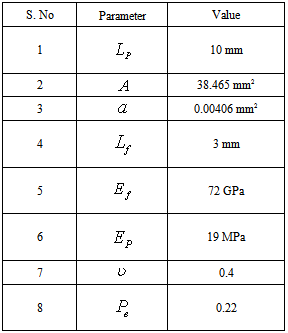-
Paper Information
- Paper Submission
-
Journal Information
- About This Journal
- Editorial Board
- Current Issue
- Archive
- Author Guidelines
- Contact Us
International Journal of Optoelectronic Engineering
p-ISSN: 2167-7301 e-ISSN: 2167-731X
2014; 4(1): 1-5
doi:10.5923/j.ijoe.20140401.01
Polymer Packaged Fiber Grating Pressure Sensor with Enhanced Sensitivity
Vengal Rao P , Srimannarayana K , Sai Shankar M , Kishore P
Department of Physics, National Institute of Technology, Warangal, 506004, India
Correspondence to: Vengal Rao P , Department of Physics, National Institute of Technology, Warangal, 506004, India.
| Email: |  |
Copyright © 2012 Scientific & Academic Publishing. All Rights Reserved.
This paper presents the development of a high sensitive pressure sensor employing an etched FBG encapsulatedin a partially-polymerfilledmetal cylinder. The sensor works by means of transferring radial or lateral pressure into an axially stretched-strain along the length of the FBG. The sensor was placed in a well-controlled pressure chamber and tested up to 0.1 MPa.The pressure sensitivity of the sensor is found to be 2.579 x 10-2 MPa-1 which is well agreed with the simulated results. The test results show that the sensor possess good linearity and repeatability within the range of pressure measurement. This compact and low cost design of the sensor can be used for static and dynamic pressure measurements in industrial applications.
Keywords: Fiber Bragg Grating (FBG), Etched fiber, Pressure, Silicone rubber, Sensitivity
Cite this paper: Vengal Rao P , Srimannarayana K , Sai Shankar M , Kishore P , Polymer Packaged Fiber Grating Pressure Sensor with Enhanced Sensitivity, International Journal of Optoelectronic Engineering, Vol. 4 No. 1, 2014, pp. 1-5. doi: 10.5923/j.ijoe.20140401.01.
Article Outline
1. Introduction
- The rapid development of the FBG sensing technology has led to increasing research activity aimed to measure wide variety of measurands namely strain, temperature, pressure, salinity, rotation, refractive index and voltage in industrial applications. These sensors have distinct advantages over the conventional sensors such as non-conductivity, high sensitivity, fast response, multiplexing capabilities, more stability and repeatability, compact structure, insensitive to electromagnetic fields and wavelength encoded response in measurements[1-8]. In the field of pressure sensing, sensitivity is an important parameter since it determines the resolution and accuracy of the sensing system. To enhance the pressure sensitivity many approaches have been proposed. The pressure sensitivity of -2.02×10-6 MPa-1 measured with a bare FBG[9]. The sensitivity has been enhanced experimentally to -2.12×10-5 MPa-1 by mounting the FBG in a hollow glass bubble[10]. Afterward, the pressure sensitivity improved up to -6.28×10-5 MPa-1 by coating the FBG with a polymer[11]. In other experiments, the pressure sensitivity of -1.73×10-3 MPa-1 was reported[12]. Further, increased the pressure sensitivity as high as -3.41×10-3 MPa-1 by embedding an FBG into a polymer filled metal cylinder which has an opening one side and shielded from the other[13]. Moreover,a special mechanism was proposed for improving the pressure sensitivity of an FBG sensor up to 2.2×10-2 MPa-1[14].Present study details a pressure sensor with enhanced sensitivity achieved by packaging an etched FBG in a partially-polymerfilledmetal cylinder. The polymer (Silicone rubber) acts as a transducer element to transfer the applied pressure effectively to the FBG and thereby, increasing the pressure sensitivity. A thin circular metal plate is bonded to one end of the FBG, facilitates the sensor to achieve high sensitivity.
2. Sensor Design and Principle
2.1. Sensor Head Design
- The details of the designed sensor head is shown in figure 1. It consists of a stainless steel cylinder of length 13 mm which is closed at one end, has an inner diameter and wall thickness measure 8.5 mm and 3 mm respectively. Two opposite side holes measure 7.5 mm in diameter are drilled on the cylindrical wall facilitate the polymer to transmit the applied pressure to the FBG.The fiber is allowed to pass through 1 mm hole drilled at closed end of the metal cylinder, facilitates the FBG positioned along the axis and opposite to side holes of the cylinder. To enhance the pressure sensitivity the fiber diameter is reduced at the FBG region by wet chemical etching process. The fiber was etched using 40% of hydrofluoric acid (HF) for 27 minutes at room temperature. After etching, the fiber was thoroughly rinsed with acetone and methanol to remove acid residuals. The etched region being smaller in crosssection experienceslarger strain and index changes than the unetched region[15]. Using an optical microscope with CCD camera attached, image of the etched fiber before and after the etching are taken. Figure 2 shows the image of etched fiber and itsdiameter is measured using MATLAB.
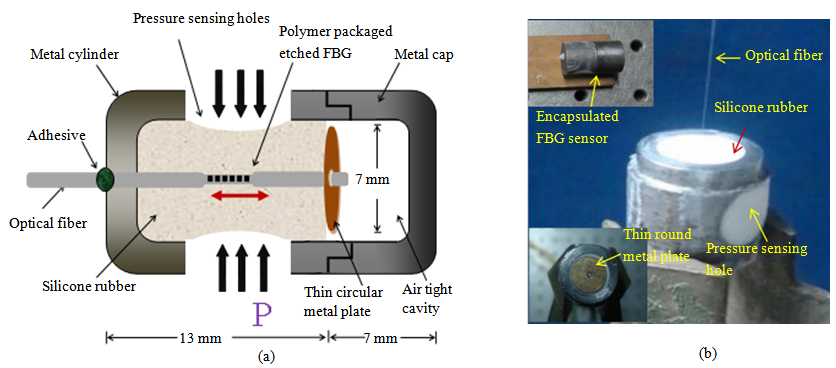 | Figure 1. (a) Schematic and (b) Photograph of the polymer packaged FBG pressure sensor |
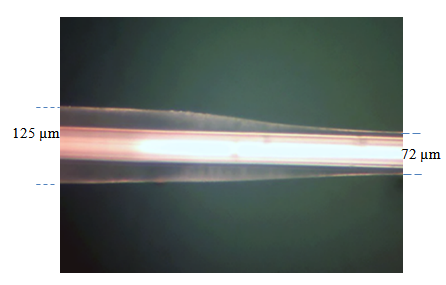 | Figure 2. CCD image of the fiber shows etched and unetched regions |
2.2. Working Principle
- A well-known relation between the relative shift in Bragg wavelength of FBG,
 and the axial strain
and the axial strain  applied to the grating at constant temperature is given by
applied to the grating at constant temperature is given by | (1) |
 is the effective photoelastic coefficient of the optical fiber,
is the effective photoelastic coefficient of the optical fiber,  is the Poisson’s ratio,
is the Poisson’s ratio, 
 are the photoelastic coefficients, and
are the photoelastic coefficients, and  is the effective refractive index of core guided mode. Typically for a fused silica fiber
is the effective refractive index of core guided mode. Typically for a fused silica fiber  = 0.22[1]. When the sensor head is subjected to pressure, polymer inside the cylinder experiences a compression causes axial force acting on the thin circular plate, results in an axial strain
= 0.22[1]. When the sensor head is subjected to pressure, polymer inside the cylinder experiences a compression causes axial force acting on the thin circular plate, results in an axial strain  experienced by the FBGcan be written as[14].
experienced by the FBGcan be written as[14].  | (2) |
 is the pressure acting on the polymer,
is the pressure acting on the polymer,  isarea of the thin circular metal plate,
isarea of the thin circular metal plate,  is cross sectional area of the fiber,
is cross sectional area of the fiber,  is polymer Poisson’s ratio,
is polymer Poisson’s ratio,  is length of the FBG,
is length of the FBG,  is length of the polymer,
is length of the polymer,  and
and  represent Young’s modulus of FBG and polymer respectively. From equation (1) and (2), the fractional change in Bragg wavelength with respect to applied pressure can be written as
represent Young’s modulus of FBG and polymer respectively. From equation (1) and (2), the fractional change in Bragg wavelength with respect to applied pressure can be written as | (3) |
 is pressure sensitivity coefficient of the sensor.To evaluate theoretical pressure sensitivity of the sensor, the values of the parameters listed in table 1 areused to simulate equation 3 using MATLAB software. The simulated results show that the relative shift inBragg wavelength as a function of applied pressure is found to be 2.341×10-2 MPa-1.
is pressure sensitivity coefficient of the sensor.To evaluate theoretical pressure sensitivity of the sensor, the values of the parameters listed in table 1 areused to simulate equation 3 using MATLAB software. The simulated results show that the relative shift inBragg wavelength as a function of applied pressure is found to be 2.341×10-2 MPa-1.
|
3. Experiment
- The photograph of the experimental setup for pressure sensing is shown in figure 3. An FBG, fabricated by using phase mask technique having 3dB bandwidth of 0.3 nm a nd peak wavelength at 1553.05 nm is used for pressure sensing. To test the pressure response, the sensoris placed in adesigned well controlled pressure chamber. The pressure inside the chamber is varied by using a compressor and controlled with reference to a precision pressure gauge. Light from a broadband superluminescent diode (SLD, 1525-1565 nm) is launched into the FBG through an optical circulator. The reflected spectrum of the FBG then routed into the optical circulator and is directed to optical spectrum analyzer (OSA). Pressure loaded in the pressure chamber tends to compress the polymer along its radial direction causes an axial force acting on the thin metal round plate leads to create an axial strain in the FBG. The pressure is increased up to 0.1 MPa insteps of0.02 MPa and corresponding shift in Bragg wavelength of FBG is recorded using OSA.
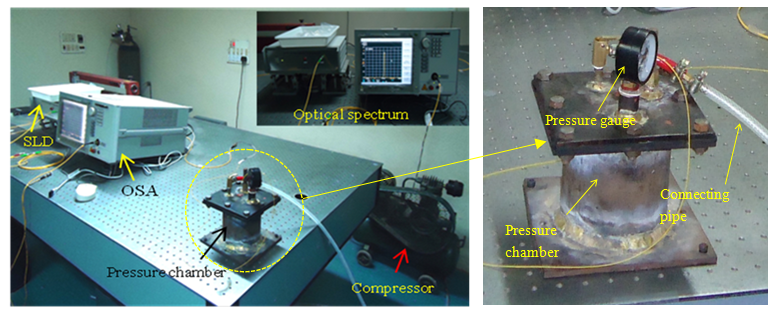 | Figure 3. Photograph of the experimental setup and self-designed pressure chamber |
4. Results and Discussions
- Figure 4 shows the recorded OSA spectrums of the Bragg wavelength shift of FBG corresponding to the applied pressure at 0.02, 0.04, 0.06 and 0.1 MPa. The total Braggwavelength shift of FBG is found to be 3.96 nm over a span of pressure variation 0-0.1 MPa. Figure 5 shows the theoretical and experimental results of the Bragg wavelength shift of FBG against applied pressure. As the pressure increases the Bragg wavelength shifts linearly with a linear coefficient of 0.9981.The measured pressure sensitivity is found to be 2.579×10-2 MPa-1 which is in close order of magnitude with the theoretically calculated sensitivity of 2.341×10-2 MPa-1.
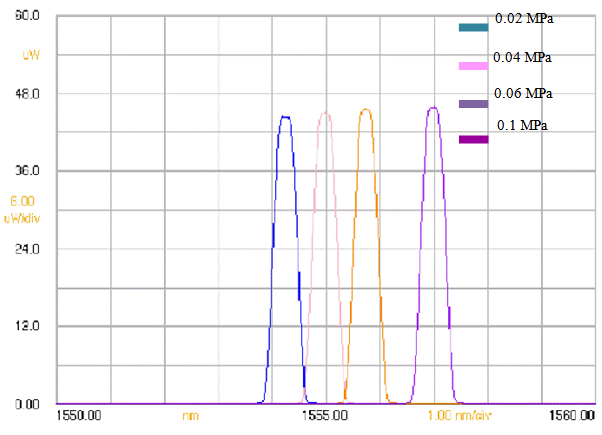 | Figure 4. Bragg wavelength shift of FBG against applied pressure recorded by OSA |
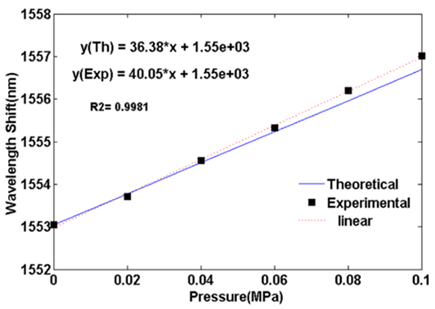 | Figure 5. Comparison between experimental andtheoretical results |
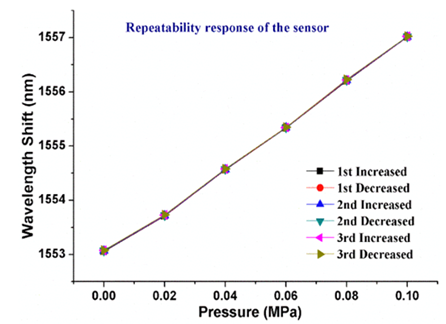 | Figure 6. Response of the sensor for repeated measurements at room temperature |
5. Conclusions
- In summary, a high sensitive FBG pressure sensor is designed and demonstrated. The pressure sensitivity is enhanced by reducing the fiber diameter and encapsulating in a polymer filled metal cylinder. Test results reveals that the designed sensor has good linearity and repeatability in pressure measurements with a negligible hysteresis error. Simple in design and compact sensor can be used to monitor liquid level, depth of under water and down-hole pressure.
ACKNOWLEDGEMENTS
- The authors thank Dr. Balaji Srinivasan, associate professor in the department of Electrical Engineering, IIT Madras, India for providing FBGs and Ministry of Human Resource Development (MHRD), Government of India, for providing fellowship to carry out the research work.
 Abstract
Abstract Reference
Reference Full-Text PDF
Full-Text PDF Full-text HTML
Full-text HTML